Winjupos and Processing Jupiter Images
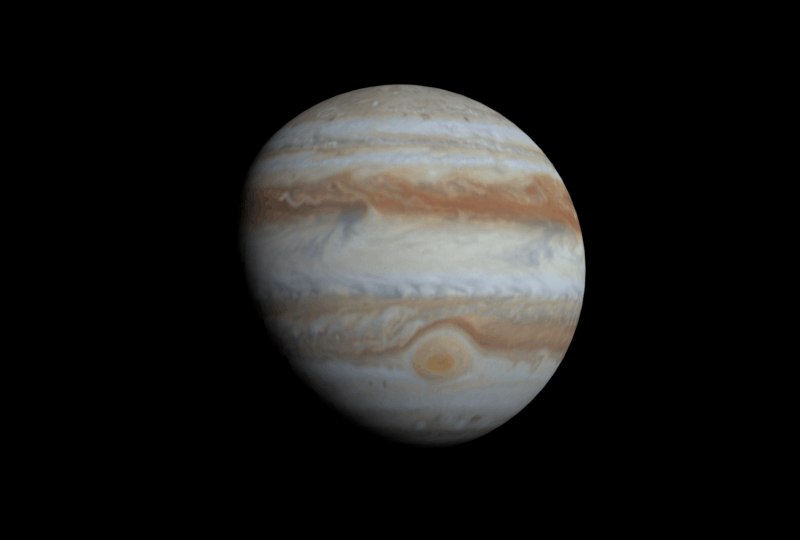
Jupiter has a complex series of cloud bands that race around the planet at different speeds. This animation shows Jupiter viewed at a fixed System II longitude (I discuss this in the text below) and was generated by the author using data from the Cassini mission and Blender. Data Credit: NASA/JPL/University of Arizona
One of the most rewarding objects to observe in the sky is Jupiter, and right at the moment, the planet can be seen to advantage in the late evening sky. I wrote recently about Jupiter in this recent blog post. It might come as a bit of a surprise that amateur astronomers can assist professional astronomers and space missions by monitoring the Planet's atmosphere. In this article, I will give a taste of the types of observations that can be made using an amateur level telescope and some free but powerful software called Winjupos.
Just recapping, Jupiter has a diameter of 140,000km making it well over ten times the width of the earth. It rotates so fast that planet bulges noticeably at the equator, and a day on Jupiter is just 10 hours. Because of Jupiter’s size, it shows the largest apparent diameter of any planet as seen from the earth except for Venus for a few days around inferior conjunction. These means that it is the easiest planet to resolve detail on and even amateur astronomers can image features as small as 1000km (Hubble can see details down to 300km). In fact, observations by amateur astronomers are often used to assist professional astronomers.
Admiring Jupiter (the bright star) over in the east from my backyard. The telescope is a 36cm diameter Celestron and was used to capture many of the images in this article
Cloud Features
Jupiter does not have a solid surface unless you go very deep into it's interior so what is visible are the cloud tops. These cloud top's reveal intense weather systems with massive storms and powerful winds undisturbed by friction from landmasses. The clouds organize themselves into bands and zones according to latitude, which is evident in the following image. There is a somewhat cumbersome naming convention that goes along with this, for instance, there is a South Temperate Belt (STB), a South South Temperate Belt (SSTB) and finally a South South South Temperate Belt (SSSTB)! Because of this, only the more significant features are shown here to avoid confusion.
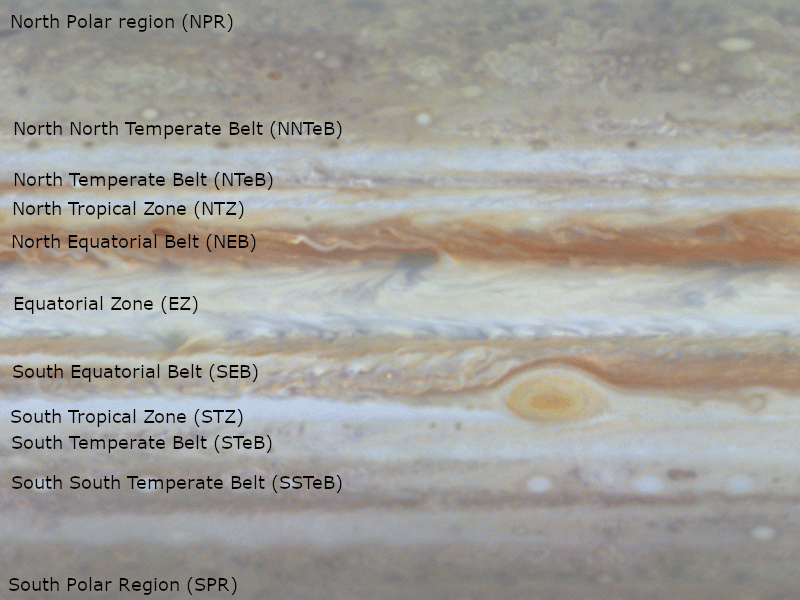
Jupiter's main zones and belts are shown here. This animation shows Jupiter viewed with the System II longitude fixed and was generated using data from the Cassini mission. Data Credit: NASA/JPL/University of Arizona
The North and South Equatorial Bands
The most prominent feature visible in a small telescope on Jupiter is the North and South Equatorial Bands, which have been given the designations NEB and SEB. Appearing as a pair of mauve/orange stripes across Jupiter's creme colored disk these are constant features of the planet although they do wane and ebb in prominence over the years.
Between the North and South Equatorial Bands is the Equatorial Zone (EZ) which races around the equator with speeds up to 500 km/hr. In animations, it appears like a conveyor traveling rapidly relative to the surrounding regions. The Equatorial zone is believed to be high altitude Ammonia clouds leading to its light color, while the Equatorial Bands on either side are clear of high altitude cloud, so we look deeper into the atmosphere.
The origin of the pastel colors is probably a result of ammonium hydrosulfide or ammonium sulfide that is present in small quantities in the mostly Hydrogen and Helium atmosphere.
The Great Red Spot
No doubt the most famous Jovian feature would be the Great Red Spot (GRS) an enormous storm that has raged for centuries, and likely formed before the invention of the telescope. Somewhat surprisingly, it is not that conspicuous in a small telescope, maybe because it's color has paled slightly in recent times. It has also shrunk considerably in size in the past few decades. Despite this, it is still a formidable feature larger than the earth.
The Temperate Zones and Belts
The Temperate Belts appear to display less activity but are in no way less impressive than the equatorial regions. For instance in the South South Temperate Belt features many white Ovals which are anti-cyclonic systems, some of which have been known to last several decades.
The Polar Regions
The polar regions are quite difficult to observe from earth because we can only see them at a very shallow angle. One of the primary objectives of the recent JUNO mission was to find Jupiter's polar regions.
Summary of Features
Jupiter's Atmosphere contains many different types of observable phenomena. Observations of the size, color, and movement of these features are encouraged by amateur astronomers. Here are some examples:
| Feature | Image | Description |
|---|---|---|
| Belts | 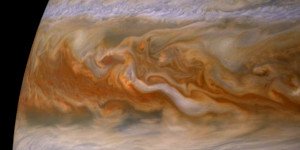 | These are regions that are relatively warmer and are free of high altitude clouds allowing views to the colorful troposphere underneath. Sulfur or Phosphorus compounds may be responsible for the coloration. |
| Jets | 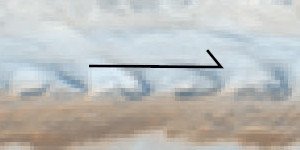 | Jets and Jetstreams can be seen at the boundary of belts and are high velocity |
| Zones | 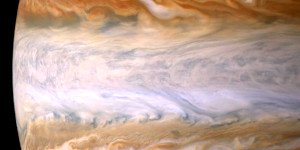 | These are light bands consisting of high Altitude clouds of white ammonia |
| Cyclones | 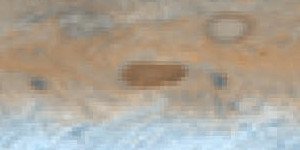 | These are smaller dark objects and often manifest as elongated brown ovals or barges |
| Anti-Cyclones |  | The white ovals and Great red spot are anti-cyclone vortices where wind speeds have been estimated at 600 kph. These features can last many years (centuries in the case of the Great Red Spot) |
| Impacts | 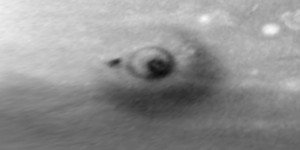 | Every few years an impact is observed that can leave a dark marking on the planet, all of the recent impacts have been found by amateur astronomer's who constantly monitor the planet |
Image Credits: NASA/JPL-Caltech/Space Science Institute
Winjupos
Winjupos is an excellent free application available that provides cartography functions for planetary images. Data obtained from Winjupos can be used to track Jupiter's features. Here is an example of how it can be used.
You can download and install Winjupos from here.
Making Jupiter Observations
Latitude and Longitude is a non-trivial matter on Jupiter. Unlike on earth, there is no surface, and the visible cloud tops travel at different speeds relative to one another, so longitude is challenging to define. Luckily, latitude is relatively fixed since there is a clear rotational axis in the clouds. In the end, astronomers have come up with three separate longitude references called system I, II and III. These systems are defined as follows.
| Longitude System | Defined By | Period |
|---|---|---|
| I | The mean motion of the Equatorial Zone, a zone of fast moving Ammonia clouds | 9h 50m 30s |
| II | The mean motion of much of the remaining Jovian clouds, like the Great Red Spot | 9h 55m 41s |
| III | Magnetosphere, Official rotation | 9h 55m 30s |
When making observations of Jupiter, it is normal to specify Central Meridian, for all three longitude systems. The central meridian is the longitude most central on the planet at the time of observation. Winjupos assists in this process and enables the following example output.
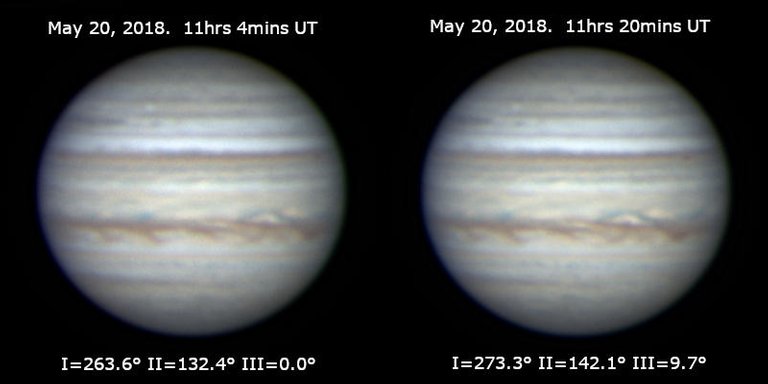
Winjupos has been used to calculate the Central Meridian in System I, II and III longitudes in these images.
In addition to computing the central meridian, Winjupos also determines data such as the orientation of North/South, image scale, and limb darkening. This information enables some exciting applications to performed including derotation and mapping. Let's look at the functions.
De-rotation
High-resolution imaging of Jupiter will clearly show the planet's rotation in less than a minute. In previous articles, I discussed the benefits of stacking and with Jupiter best resolution might require up to 30 minutes of exposures. In this time the planet will have rotated significantly, causing detail to be blurred as shown n the following left-hand image. Winjupos, can compensate for this and de-rotate the images as seen at the right.

The image below left, is the result of stacking 18 minutes of video of Jupiter. The planet appears blurred from it's rotation. However, when Winjupos is used to de-rotate the image stack a much sharper result is possible (as seen on the right). Credit:Author
Mapping
Another fascinating application of Winjupos is the ability to render planetary images in some different projections. Here is an example of images of Jupiter from May 18 and May 19, 2018, unwrapped in a cylindrical projectionhere.. Winjupos is an excellent tool for monitoring changes in a planetary atmosphere. Btw if you want to know more about different mapping projections, please head over to @lordneroo 's blog
As an interesting exercise, I was able to get two consecutive nights with good conditions and was able to obtain images of the same part of the planet 21 hours apart. These observations enabled the measurement of the movement of some features in the cloud-tops. Here is an example of a calculation of wind speed computed for a jetstream jet from these two nights of observations.
Observation from May 18,2018
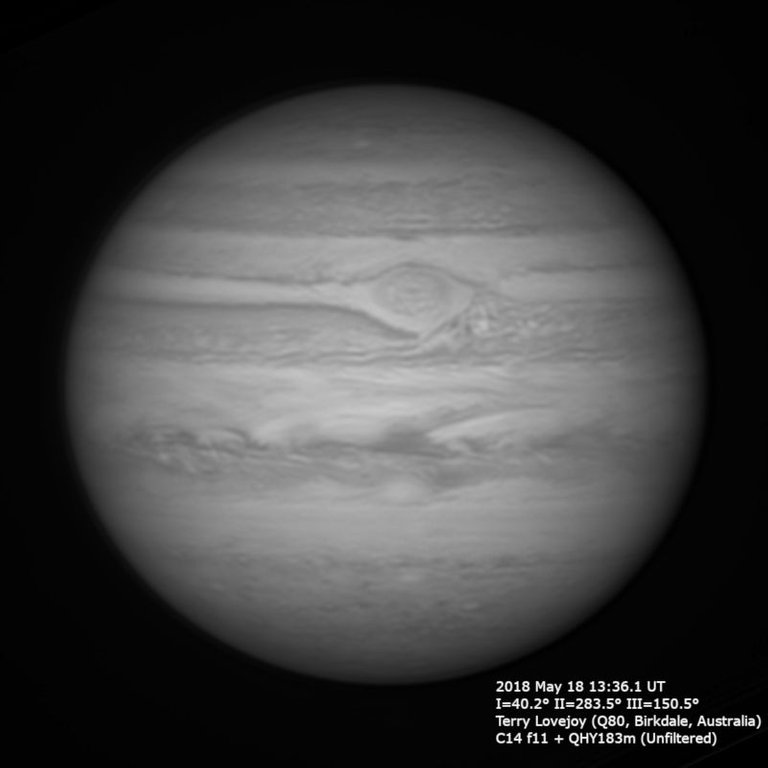
Direct image of Jupiter in Winjupos on May 18, 2018 (13hrs 36mins UT). Image Credit: Author
Using Winjupos to project this image to a cylindrical projection.

Cylindrical projection of Jupiter in System II longitudes using Winjupos of image above on May 18, 2018 (13hrs 36mins UT). Image Credit: Author
Observation from May 19, 2018
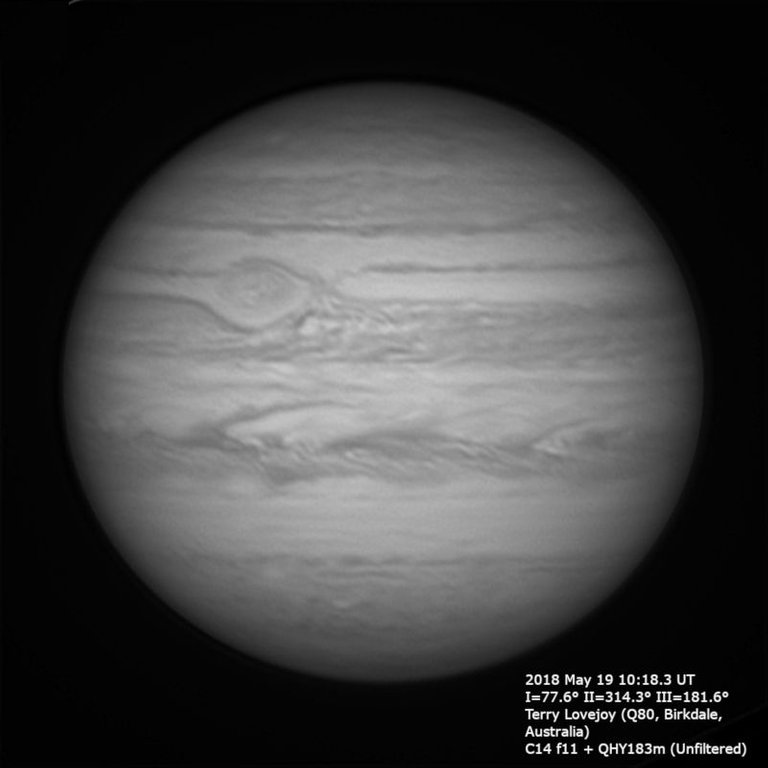
Direct image of Jupiter in Winjupos on May 19, 2018 (10hrs 18mins UT). Image Credit: Author
Using Winjupos to project this image to a cylindrical projection.

Cylindrical projection of Jupiter in System II longitudes using Winjupos On May 19, 2018 (10hrs 18mins UT). Image Credit: Author
A prominent chevron shaped feature was identified in the jet stream on the boundary of the North Equatorial Belt as shown in the following images. Using Winjupos the longitude and latitude of the point of the chevron were determined.
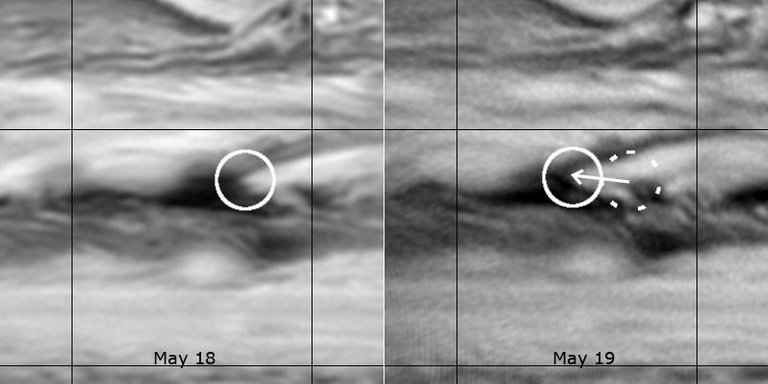
Enlargement from the May 18 and May 19 images above, showing a feature in the Equatorial zone that has moved a distance of 8500km in 21 hours
Here are the observations.
Observation 1:
Time: May 18 13hrs 36mins
Longitude (System II): 291.3° (Measured from Winjupos)
Latitude : 6° North
Observation 2:
Time: May 19 10hrs 18mins
Longitude (System II): 284.4° (Measured from Winjupos)
Latitude : 6° North
Here are the calculations.
Using an approximate radius of Jupiter of 70,000km, and assuming this feature is on the equator, the actually actual data computed is as follows:
Movement in Longitude = 291.3 - 284.4 = 6.9°
Movement in km = 6.9° x (𝜋 / 180) * 70,000km = 8,430km
Time Duration between observations = 20.7 hours
Computed Wind velocity = 407 km/hr
This value is definitely in the ballpark of quoted figures which state that wind speed is up to 500 km/hr.
Conclusions
Jupiter has a fascinating weather system that can be observed in extensive detail even by amateur astronomers from the suburbs. If you get a chance go point, even a small telescope, towards Jupiter as rises in the east these May evenings.
References
- Gray, Bill. Formula for Jupiter's Central Meridians and Great Red Spot Transits. Accessed May 23, 2018. https://www.projectpluto.com/grs_form.htm.
- A Guide to Jovian Activity. Accessed May 23, 2018. http://www.britastro.org/jupiter/guide.htm.
- Where Did You Get Those Stripes? Accessed May 23, 2018. https://www.nasa.gov/centers/goddard/multimedia/largest/atmosphere.html
- Jupiter’s Great Red Spot: A Swirling Mystery. Accessed May 23, 2018. https://www.nasa.gov/feature/goddard/jupiter-s-great-red-spot-a-swirling-mystery
- Zenographic longitude systems and Jupiter's differential rotation. Accessed May 23, 2018. http://rsnr.royalsocietypublishing.org/content/55/1/69
- Jupiter's Jet Streams. Accessed May 23, 2018. https://svs.gsfc.nasa.gov/10981
- NASA Juno Findings - Jupiter’s Jet-Streams Are Unearthly. https://www.nasa.gov/feature/jpl/nasa-juno-findings-jupiter-s-jet-streams-are-unearthly
- Rogers, John H. The Giant Planet Jupiter. Cambridge: Cambridge University Press, 2009.
Please note all images are the authors (unless otherwise noted)

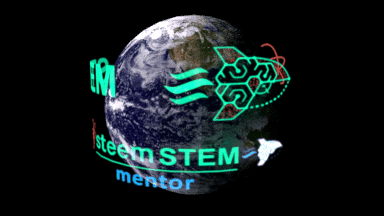
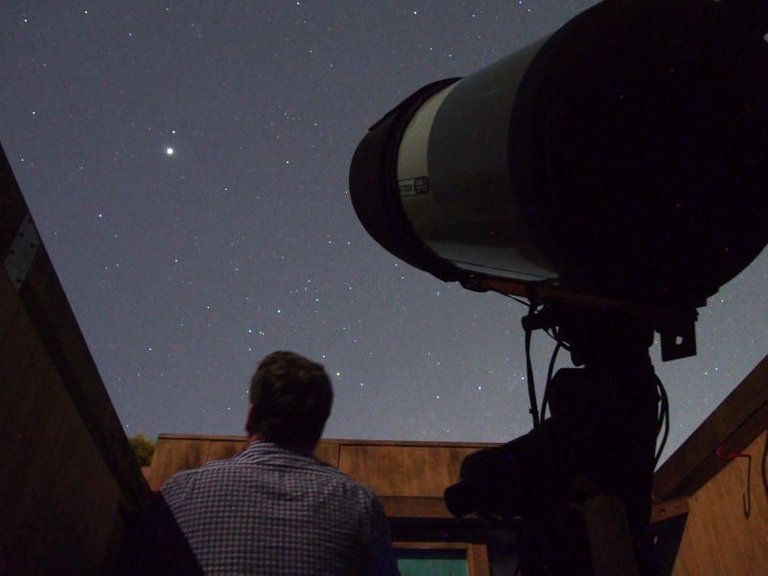
Great article Terry! Learned some really interesting new things about Jupiter.
You're pictures look awesome. 36cm aperture would be a dream for me but is a little bit too much for my mount.
Thank you Kevin, as is the mount I have is at it's limit and I really need a heavier duty mount. That might be my next purchase.
You are welcome Terry :-)
Unfortunately, there is a magical border at around 20kg load capacity. As soon as they can handle more weight the price will rise exorbitantly.
I'm thinking of either an EQ8 or a CGX-L. Not sure of your thoughts on either.
I think you are currently using a CGEM, so the CGX-L would be the better decision if you are satisfied with your CGEM. But the EQ8 could handle more payload. Also, the software between both is very different and if you feel comfortable with Celestron you might have a new learning with the Skywatcher. This is no easy decision.
It is so cool we have the necessary tools to study objects with such a huge distance from us. I have never heard of Winjupos but it does sound interesting.
that means it would be impossible to stand with our feet in the surface of Jupiter?
Agree it is seriously cool, and these tools have advanced tremendously in the last few decades!
No chance of ever standing on Jupiter. Unfortunately, you will be killed and assimilated into the planet long before you got to anything solid!
I have a 10 inch Meade light bucket. My favourite part of looking at Jupiter is watching the shadow of the moon Io when it crosses Jupiter's face.
Yes that is cool watching the moon's shadow pass across the face of Jupiter!
Thank you for your great work @terrylovejoy and for the effort you put into this!
STB, SSTB and SSSTB sounds too funny! I mean it's practical, but I had to say this! :P
I was impressed by your calculation of windspeed based on those two observations of yours and kept wondering to which extent the planet's rotation around its axis would affect your calculations. I guess it would still make no big difference in your estimations.
Thank you so much for the shout out! I'm honored.
Have a great day!
Thinking about the windspeed calculation it is technically misleading, because it relative to system II so you may not experience anything like this directly as the point of reference is several thousand km away. If you were floating along in the jet stream you might not notice much at all. I'll have to think of a better term for this.
Anyway, thanks for stopping by!
Again, thank you so much for including my work! I'm humbled!
Keep up the awesome work!
Hi @terrylovejoy! Quite a long while after which we will have a conversation. The article is quite interesting with an added flavor of the images taken by you with the help of your telescope and camera. The images are quite fascinating!
I loved it and learnt quite many things here in an updated way by your efforts!
Thanks for bringing this interesting post up!
Cheers! :)
We are all contributing to bringing it up :D
He wrote it, we vote it and we are discussing it. Not minimizing your work in any way @terrylovejoy! Where is @svemirac, he was also posting nice articles..
Yes ofcourse @alexdory discussion is a very important part which plays a vital role in unfolding many unknown mystery with joint effort! I always give it a lot of preference. :)
Thank you both! Yes where is @svemirac these days :)
Hello everyone, I am glad that you still remember me and my work :) Great new articles btw. Svemirac is kinda coping with life and another PhD application and maintaining to curate here-and-there. :)
Gonna post soon (two-part) post about the Sun and start that solar system series, as soon as I find some time, and rest a bit.
Cheers great STEMers :) @terrylovejoy @Alexdory @star-vc
Excellent. I really want to see more data being gathered and analyzed from the Juno spacecraft, which might get an extension to the mission this year.
I have said it many times, you are lucky to get to look at the planets from your back yard :P
Let us hope they get more mission data. Incidentally, JUNO are requesting more images from amateurs particularly in the next 72 hours. It's also cool to be able to make (even if small) contributions to space missions!
Why is that? What do they want to coroborate?
For planning observations primarily, amateurs can give them a broad idea of what is happening in the atmosphere as JUNO pass perijove on May 24 (closest approach). I believe they are planning observations using the VLT in Chile, but they have a limited time window that they can observe Jupiter.
Presumably, amateurs can help fill in gaps. From this side of the world I know Anthony Wesley (Australia) and Chris Go (Philippines) make high resolution images of Jupiter perhaps 2-3x inferior to Hubble. These guys are both amateur astronomers.
There is quite a lot of pro-am cooperation with astronomy.
That's a great writeup, I look at Jupiter in a new light now! As you note, lots of people like me know about the great red spot but seeing the bands of super fast storms was also pretty eye opening! The picture of you looking into the sky helps too, hadn't really realized that to the naked eye Jupiter looks like a bright star
It is indeed very easy to see Jupiter with the naked eye as a very bright star.
If you have an Android mobile phone, try downloading SkyMap on Android.
It uses the sensors of your phone and compass and you search for Jupiter and then point the phone in the direction of it. Then you look behind the screen and you see the real Jupiter :D
In all, the most famous one is the red spot. As you said it is shrinking, so is it possible that the cyclone will stop in future and the whole environment will become more suitable. Although I guess it will never be suitable for us untill we achieve more knowledge of technology.
Or may be we need some alien technology....😄
More suitable, what for landing? There is a small problem of no solid ground, so you would need some type of airship and navigate it to avoid areas of high turbulence.
I don't know if only the red spot is the culprit for the weather :D
I would like to think that we could survive there, at least in a spacecraft..
The red spot is only part of the weather system. Regarding traveling there it would be pretty unpleasant for humans (as well as electrical equipment) as you need to shielding against Jupiter's intense radiation belts. On top of that if you were able to float around the cloud tops you would weight nearly 3 times as much!
I know, I saw a detailed info-graphic of the radiation belts there and on Saturn and how spacecraft avoid them when possible.
I seem to remember even some of the inner moons were deemed too dangerous to travel to. The magnetic field of Jupiter is many order's of magnitude stronger than earth's and there are a lot of high energy charged particles flying about. For this reason I think our first human trips would be to either Europa or Callisto.
Thank you Terry for this great article! As a fan of astronomy, I became curious to download Winjupos!
Thank you @akouta ! Do you have a telescope or camera?
Unfortunately no!
Congratulations @terrylovejoy! You have completed some achievement on Steemit and have been rewarded with new badge(s) :
Click on any badge to view your own Board of Honor on SteemitBoard.
To support your work, I also upvoted your post!
For more information about SteemitBoard, click here
If you no longer want to receive notifications, reply to this comment with the word
STOPIt's awesome, Nice post, beautiful post and amazing pics.
I love so much astronomy and cosmology.
I will be happy cause i posted about the soundtrack of the Interstellar movie recently.
I hope you that like it.
have good time.
Świetna robota.